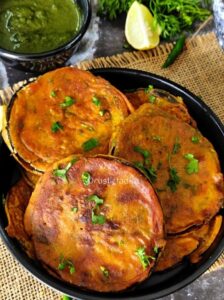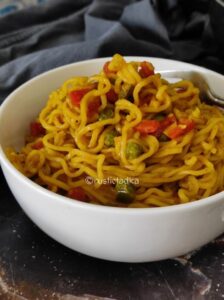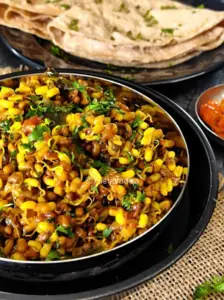Kande pohe is a classic Indian breakfast recipe originating in the west coast of India, especially in Maharashtra and Gujrat.
Kande means onion, finely chopped onions are used in this recipe. Pohe or poha means flattened rice/ beaten rice that is parboiled at first and then flattened.
This is a healthy iron-rich vegan, breakfast recipe.
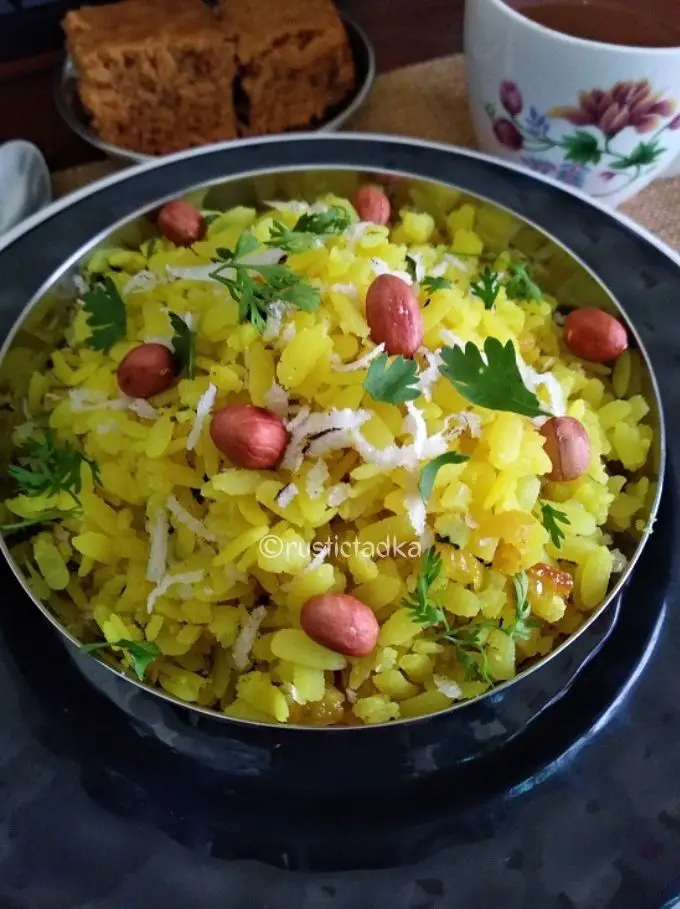
[convertkit form=7110706]
About Kande Pohe
Poha also known as pohe, pauwa or aval is one of the most sought breakfasts all over India.
Made with flattened rice, onions, and green chilles this kande pohe is served with a hot cup of tea or coffee.
There are many variations of making pohe.
The most popular is kande pohe, which is pohe made with finely chopped onions, and then there is batata pohe which is potato pohe in which thin slices of potatoes are used either with finely chopped onions or without onions.
Boiled green peas are also added sometimes in making poha which enhances the taste, and texture and boosts the nutritional value of this poha, this one is known as matar poha.
Many times finely chopped tomatoes are added to make pohe.
So mainly it depends upon region to region and also on the personal taste which kind of pohe variation one makes.
At our home, we love to have kande pohe but on some days we opt for batata pohe (potato pohe) too, just for a change.
Whatever may be the versions of making pohe. Each variation is unique and delicious!
Making kande pohe is very easy and quick. Hence it’s the favoured breakfast dish.
It’s a delicious comfort food best for breakfast or even as an evening snack.
In Indian homes, when an unexpected guest arrives they are mostly offered kande pohe along with hot beverages as it can be made in under 15-20 minutes.
It’s that popular and comforting. Pohe is loved by all from kids to elders.
In the morning all along the streets of Maharashtra, you will notice cart vendors selling this kande pohe that is topped with sev along with a wedge of lemon.
Sev is an Indian snack made using gram flour. They are finely made noodles that are deep-fried and served as a topping in various Indian dishes.
Apart from selling this on carts, many restaurants also serve kande pohe, especially in the morning time as it is mainly eaten as a breakfast dish.
Kande pohe are loved by kids too. In our childhood, we used to carry kande pohe for our mid-day break at school.
Pohe/Poha (flattened rice) is easily available in any Indian grocery store. Always make sure to use a thick variety of pohe/Pohe for making this recipe.
As poha is already parboiled before flattening, it helps cut down the cooking time considerably making it a perfect breakfast option when in a hurry during hectic mornings.
This flavourful healthy kande pohe is best served hot and garnished with roasted peanuts or sev or pomegranate kernels.
While serving kande pohe, lemon juice is squeezed on top which not only enhances the taste of the pohe but also helps the body absorb iron efficiently.
This humble dish requires very basic and few staple ingredients and you are good to go!
Making kande pohe is so simple that nothing much can go wrong with this recipe.
This is a perfect, beginner-friendly recipe.
The only thing to remember here is to use a thick variety of poha and not a thin one.
ingredients
Poha/Pohe (Flattened Rice) – To make kande pohe thick variety of poha is used. Do not make it with thin poha as it will get soggy and mushy.
Onion – We will need 1-2 big-sized onion, the more onion the better the taste.
Herbs & Spices – Basic ingredients such as turmeric powder, hing (asafoetida), curry leaves, green chllies & coriander leaves are needed to infuse the flavour to this kande pohe.
Apart from that, we will require mustard seeds for tempering.
Seasoning – Traditionally a teaspoon of sugar is added while making pohe which balances the flavour of this dish. Salt is added for taste.
Lemon Juice – A squeeze of lemon juice over kande pohe is a must. It helps the body absorb iron efficiently. I would highly recommend not to skip this step.
To Garnish – Garnish varies from person to person. The basic garnish includes freshly scrapped coconut, finely chopped coriander leaves and some roasted peanuts.
Many also like to add sev (besan sev) for the crunch.
Oil – We will need 2-3 tablespoons of oil. I use sunflower oil for making this kande pohe.
Frequently Asked Questions
Is Kande Pohe Vegan?
Kande pohe is naturally a vegan dish that uses plant-based ingredients.
Is Kande Pohe a healthy dish?
Yes, kande pohe is relatively healthy as it is low in fat & high in carbohydrates.
It contains fiber, vitamins and minerals and can be made more healthy by adding vegetables and nuts.
How can I make Kande Pohe more nutritious?
Try adding more vegetables, like peas, carrots, and French beans along with some nuts like peanuts for that added protein.
How can I reheat Kande Pohe?
Sprinkle some water over the poha and mix. Reheat in the microwave or stovetop.
Can Kande Pohe be a part of the party menu?
Yes, it makes for an easy-to-serve dish, especially at brunch and casual get-togethers.
Variations
There are many variations you can try to make poha.
- Adding Potatoes (Batata Poha) – Small diced potatoes are lightly fried along with onion.
- Adding Tomatoes (Tomato Poha) – Adding chopped tomatoes into the tempering along with onions makes the poha niche tangy and juicy.
- With Sprouts – Sprouts like green moong, and matki, are some of the popular sprouts added to poha to make it more nutritious.
- Paneer Poha – Add small cubes of paneer for that protein-rich variation. Taste delicious.
- Vegetable Poha – Adding various vegetables such as peas, carrots, french beans, and capsicum makes the poha more nutritional and colourful.
Serving Suggestions
Traditionally Kande Pohe is served with
Lemon Wedges – A squeeze of fresh lemon juice adds a zesty tang to this kande pohe making it taste more flavourful.
Coconut – Freshly scrapped coconut is added on top of poha while serving which give mild sweetness that balances well with the lemon juice.
Sev (Crispy Noodles) – Besan sev is normally sprinkled over kande pohe to give that crunchy texuture.
For Beverages
Tea (Chai) – Kande pohe and tea make the best combination & more so if it’s adrak chai (ginger tea)!
Coffee – A strong, freshly brewed coffee is a great accompaniment to kande pohe.
Other Options
Roasted Peanuts are added for extra crunch and protein.
Pomegranate Seeds add a sweet & tart flavour that pairs nicely with savoury pohe.
Storage Options
Kande pohe tastes delicious when served hot and fresh.
They tend to dry out if stored for a long time.
The leftover poha can be repurposed into recipes like adding while making snacks in pakodas, samosa, vegetable cutlets or even in parathas.
Related Recipes
More Maharashtrian Breakfast Recipes
Dadpe Pohe (No Cook Poha Recipe), Sanja (Tikhat Methacha Sheera), Sabudan Khichadi, Phodnichi Poli, Rajgira Poori, Policha Ladoo
How to make Maharashtrian Kande Pohe
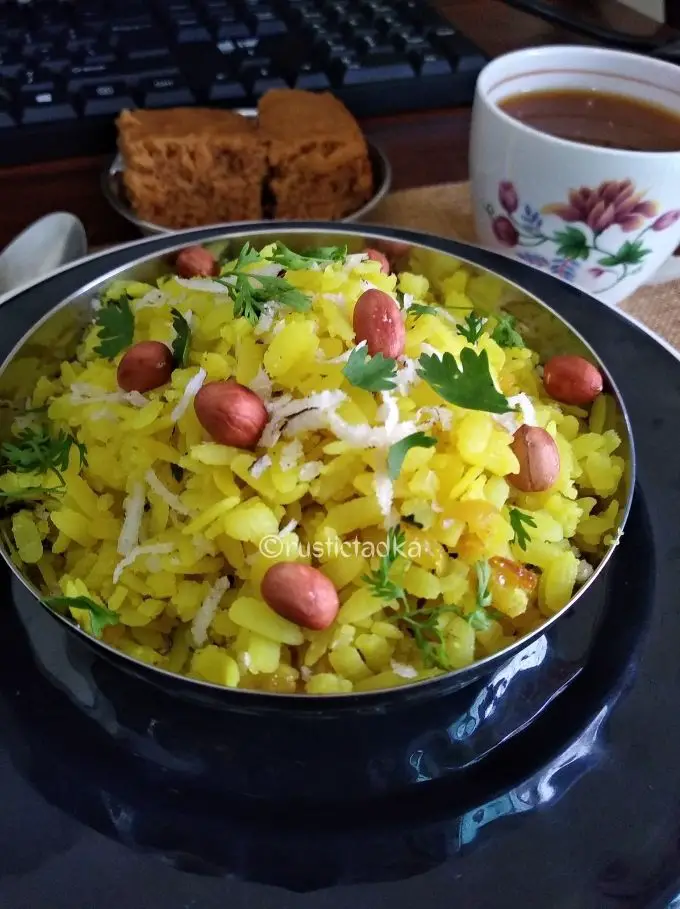
Join “Easy Indian Vegetarian & Vegan Recipes” on Facebook & be a part of our community.
If you like recipes like these, let’s connect on YouTube, Instagram & Facebook.
Thank you for stopping by, I would really love to know your thoughts on this recipe.
Also, do check out my Lifestyle Blog eralivine.com if interested.
Recipe Card

Kande Pohe – Maharashtrian Breakfast Recipe
Ingredients
Method
- To make kande pohe, we will need a thick variety of poha (easily available at any Indian grocery store)
- Using a sieve/strainer, wash pohe (flattened rice) under tap water. Drain the water and set it aside.
- In a kadhai, heat oil. Once oil is hot, add mustard seeds and let them splutter.
- Add hing (asafoetida), turmeric powder, curry leaves, finely chopped green chillies and finely chopped onions.
- Cook onions till translucent.
- Once the onions are cooked, add the soaked pohe/poha (flattened rice) along with salt and sugar. Mix well.
- Cover the pan for about 3-4 minutes, stirring occasionally.
- After 3-4 minutes of cooking the poha, add finely chopped coriander leaves and mix.
- Maharashtrian Kande Pohe is ready.
- Garnish kande pohe with roasted peanuts and freshly scraped coconut or with juicy pomegranate kernels or fine besan shev.
- Sprinkle lemon juice over kande pohe just before serving.

